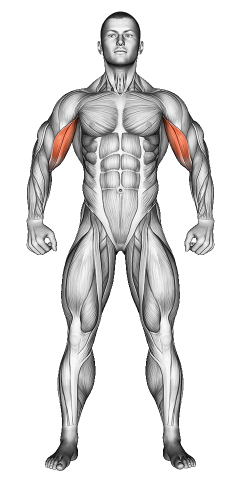Standing Barbell Curl: Video Tutorial & Exercise Guide

Written By: Claude Michael
Updated: Oct 13, 2024
| Workout | Standing Barbell Curl |
| Primary Muscle Group | Biceps |
| Equipment Required | Barbell |
| Force Type | Pull |
| Mechanics | Isolation |
| Exercise Type | Strength |
| Difficulty | Beginner |
Standing Barbell Curl: Video Tutorial & Exercise Guide
- 1.Standing Barbell Curl: Muscle Groups
- -1.1Primary Muscle Group
- -1.2Secondary Muscle Group
- 2.Standing Barbell Curl: Step-by-Step Guide
- 3.Standing Barbell Curl: Overview
- 4.Standing Barbell Curl: Benefits
- 5.Standing Barbell Curl: Pro Tips & Advanced Techniques
- 6.Standing Barbell Curl: Progression Plan
- 7.Standing Barbell Curl: Frequently Asked Questions (FAQs)
Standing Barbell Curl: Step-by-Step Guide
- Step 1: Stand with your feet shoulder-width apart, holding a barbell with an underhand grip (palms facing up). Your hands should be shoulder-width apart on the bar.
- Step 2: Keep your elbows close to your torso, your back straight, and your core engaged. Let the barbell hang down in front of your thighs with your arms fully extended.
- Step 3: Begin curling the barbell upward by bending at the elbows. Keep your upper arms stationary and focus on contracting your biceps as you lift the weight.
- Step 4: Continue lifting the bar until your biceps are fully contracted and the bar is at shoulder height. Pause briefly at the top of the movement to squeeze your biceps.
- Step 5: Slowly lower the barbell back to the starting position, controlling the descent to maintain tension on your biceps. Repeat for the desired number of reps.
Standing Barbell Curl: Overview
The Standing Barbell Curl is a classic bicep-building exercise that targets the biceps brachii, brachialis, and brachioradialis muscles. This exercise is effective for building arm strength and size while promoting better muscle definition in the upper arms. The barbell curl is a staple in most arm workout routines due to its simplicity and effectiveness in isolating the biceps.
Suitable for all fitness levels, the Standing Barbell Curl is a great addition to any upper-body workout routine. It can help improve both muscle mass and strength while enhancing overall arm aesthetics.
Standing Barbell Curls: Benefits
Standing Barbell Curls are one of the most effective exercises for building strength and size in the biceps. By using a barbell, you can often lift heavier weights than with dumbbells, allowing for greater overload and muscle growth.
This exercise also engages the forearms and brachialis muscles, helping to develop well-rounded arm strength. Additionally, performing the curl in a standing position engages your core and lower back muscles to help maintain proper posture, improving overall stability.
Standing Barbell Curl: Pro Tips & Advanced Techniques
To maximize the benefits of the Standing Barbell Curl, focus on slow and controlled movements, especially during the lowering phase. Avoid swinging your body or using momentum to lift the weight, as this reduces the tension on your biceps. For an added challenge, pause at the top of the movement to squeeze your biceps, or try using a wider or narrower grip to target different parts of the biceps.
Standing Barbell Curls: Progression Plan
Beginner
Intermediate
Advanced
Standing Barbell Curl: Frequently Asked Questions (FAQs)
What muscles do Standing Barbell Curls target?
+Standing Barbell Curls primarily target the biceps brachii, with additional engagement of the brachialis, brachioradialis, and forearm muscles.
Is the Standing Barbell Curl suitable for beginners?
+Yes, this exercise is suitable for beginners. Start with a lighter barbell and focus on mastering your form before progressing to heavier weights.
How often should I include Standing Barbell Curls in my routine?
+Incorporate Standing Barbell Curls into your arm routine 1-2 times per week, making sure to give your muscles adequate recovery time between sessions.
What common mistakes should I avoid?
+Avoid using your back or shoulders to lift the bar. Focus on isolating your biceps and keeping your body still throughout the movement.
Can I use different grips for the Standing Barbell Curl?
+Yes, using a wider grip emphasizes the outer part of the biceps, while a narrower grip focuses more on the inner part. Experiment with different grips to target the biceps from various angles.
Share
Don’t Wish for It, Work for It – Join the FlexXP Newsletter Today!
Thank you for signing up for the FlexXP Newsletter!
This site is protected and the Google Privacy Policy and Terms of Service apply.
